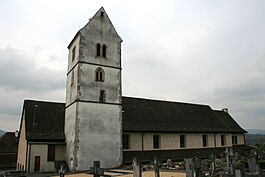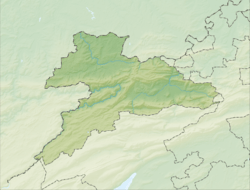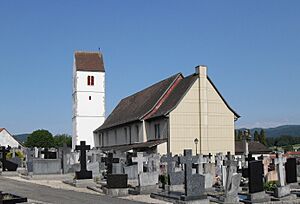Alle, Switzerland facts for kids
Quick facts for kids
Alle
|
||
|---|---|---|

Alle village church, Saint Jean Baptiste Church
|
||
|
||
| Country | Switzerland | |
| Canton | Jura | |
| District | Porrentruy | |
| Area | ||
| • Total | 10.6 km2 (4.1 sq mi) | |
| Elevation | 450 m (1,480 ft) | |
| Population
(Dec 2020 )
|
||
| • Total | 1,895 | |
| • Density | 178.8/km2 (463.0/sq mi) | |
| Postal code |
2942
|
|
| Surrounded by | Cornol, Courgenay, Porrentruy, Coeuve, Vendlincourt, Miécourt. | |
Alle (which is Alle in French) is a small town, also called a municipality, in the Jura area of Switzerland. It's part of the Porrentruy district.
Contents
History of Alle
Alle was first written about in the year 1136. Back then, it was called Alla. For a while, it was also known by its German name, Hall, but people don't use that name anymore.
Alle's Geography
Alle covers an area of about 10.66 square kilometers (4.12 square miles). A big part of this land, about 64.2%, is used for farming. This means there are lots of fields and pastures.
About 22.3% of Alle is covered by forests. The rest of the land, about 12.9%, has buildings and roads. A very small part, less than 1%, includes rivers or lakes.
Alle is located in the Porrentruy district. It sits along two rivers, the Allaine and the Cornolbach. It's one of the biggest villages in the Ajoie region. You can see special old houses from the 1600s and 1700s along the rivers.
Alle's Coat of Arms
The blazon (official description) of Alle's coat of arms is: Gules, on a Bend Argent three Torteaux. This means it has a red background. Across it, there's a silver stripe, and on that stripe, there are three red circles.
People of Alle (Demographics)
Alle has a population of about 1,895 people. In 2008, about 10.8% of the people living there were from other countries. Over the past 10 years (from 2000 to 2010), the number of people living in Alle grew by 8.6%.
Most people in Alle, about 93.1%, speak French as their main language. Italian is spoken by about 2.9% of the people, and German by about 1.6%.
In 2008, nearly half the population (48.4%) was male, and just over half (51.6%) was female. Many people, about 42.7%, were born in Alle and still lived there in 2000.
Children and teenagers (ages 0-19) make up about 26.3% of Alle's population. Adults (ages 20-64) make up 57.5%, and seniors (over 64) are about 16.1%.
Here's how Alle's population has changed over time:

Important Heritage Sites
Alle has some very old and important places. The Noir Bois is a site where people lived a very long time ago, in the Stone Age (Paleolithic) and Middle Ages. The Pré Monsieur is another Stone Age settlement. Both of these are considered important heritage sites in Switzerland.
The entire old village area of Alle is also part of the Inventory of Swiss Heritage Sites. This means it's a special place that needs to be protected because of its history and beauty.
Alle's Economy
In 2010, the unemployment rate in Alle was 4.4%. This means a small number of people who wanted jobs couldn't find them.
Many people in Alle work in different areas:
- Primary Sector: About 62 people work in farming or forestry. There are about 18 businesses in this area.
- Secondary Sector: About 810 people work in manufacturing (making things in factories) or construction (building things). There are 26 businesses in this area.
- Tertiary Sector: About 274 people work in services, like shops, restaurants, or offices. There are 55 businesses in this area.
In 2008, there were over 1,000 full-time jobs in Alle. Many of these jobs were in manufacturing. Other jobs were in sales, transportation, hotels, and healthcare.
Many people who work in Alle actually travel there from other towns. About 38.5% of the workers come from outside Switzerland. Most people (62.3%) use a private car to get to work, while 7% use public transportation.
Religion in Alle
According to a survey in 2000, most people in Alle, about 85.1%, are Roman Catholic. About 6.1% belong to the Swiss Reformed Church.
A smaller number of people belong to other Christian churches or follow Islam. Some people also said they had no religion or didn't answer the question.
Education in Alle
In Alle, about 33% of the people have finished high school (upper secondary education). About 6% have gone on to get a higher education, like from a university.
The school system in the Jura area works like this:
- Kindergarten: Two years of optional (not required) kindergarten.
- Primary School: Six years of primary school.
- Lower Secondary School: Three years of required secondary school. Students are grouped by how well they learn.
- Upper Secondary School: After lower secondary, students can choose to go to an optional high school for three or four years. They can also start an apprenticeship (learning a job while working).
During the 2009-2010 school year, Alle had 197 students in 12 classes. There were 46 students in kindergarten and 151 students in primary school. Students from Alle go to secondary schools in other towns because there are only nine secondary schools in the whole Jura area.
Transportation in Alle
Alle has a train station on the Porrentruy–Bonfol railway line. This means people can easily travel to and from Alle by train.
See also
 In Spanish: Alle (Jura) para niños
In Spanish: Alle (Jura) para niños







